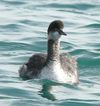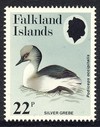Genus Podiceps

Colombian Grebe - The decline of the Colombian grebe is attributed to wetland drainage, siltation, pesticide pollution, disruption by reed harvesting, hunting, competition, and predation of chicks by rainbow trout . The primary reason was loss of habitat: drainage of wetlands and siltation resulted in higher concentrations of pollutant, caussing across Lake Tota. This destroyed the open, submergent pondweed vegetation and resulted in the formation of a dense monoculture of water weed .
Slavonian Grebe - The Horned Grebe or Slavonian Grebe, Podiceps auritus, is a member of the grebe family of water birds.
Great Crested Grebe - The Great Crested Grebe is 46-51 cm long with a 59-73 cm wingspan. It is an excellent swimmer and diver, and pursues its fish prey underwater. The adults are unmistakable in summer with head and neck decorations. In winter, this is whiter than most grebes, with white above the eye, and a pink bill. It is the largest European grebe.
Hooded Grebe - The Hooded Grebe , is a medium-sized grebe found in the southern region of South America. It grows to about 34 cm in length, and is black and white in color . It is found in isolated lakes in the most remote parts of Patagonia, and spends winters along the coast of the same region.
Red-necked Grebe - The Red-necked Grebe, Podiceps grisegena, is a migratory aquatic bird that is found in the temperate regions of the northern hemisphere. Its wintering habitat is largely restricted to calm waters just beyond the waves around ocean coasts, although some birds may winter on large lakes. Grebes prefer shallow bodies of fresh water such as lakes, marshes or fish-ponds as breeding sites.
Great Grebe - This species occurs mainly in open waterways. Most birds are seen on low altitude lakes and sluggish rivers , as well as estuarine marshes. While breeding, it frequents the heavily vegetated inlets off of large lakes. Outside of the breeding season, most birds will move to estuaries and bays, usually heavy with kelp . Non-breeding birds may live along the coasts all year.
Black-necked Grebe - There are three subspecies:
Junin Grebe - The scientific name commemorates the Polish zoologist Władysław Taczanowski, author of Ornithology of Peru .







